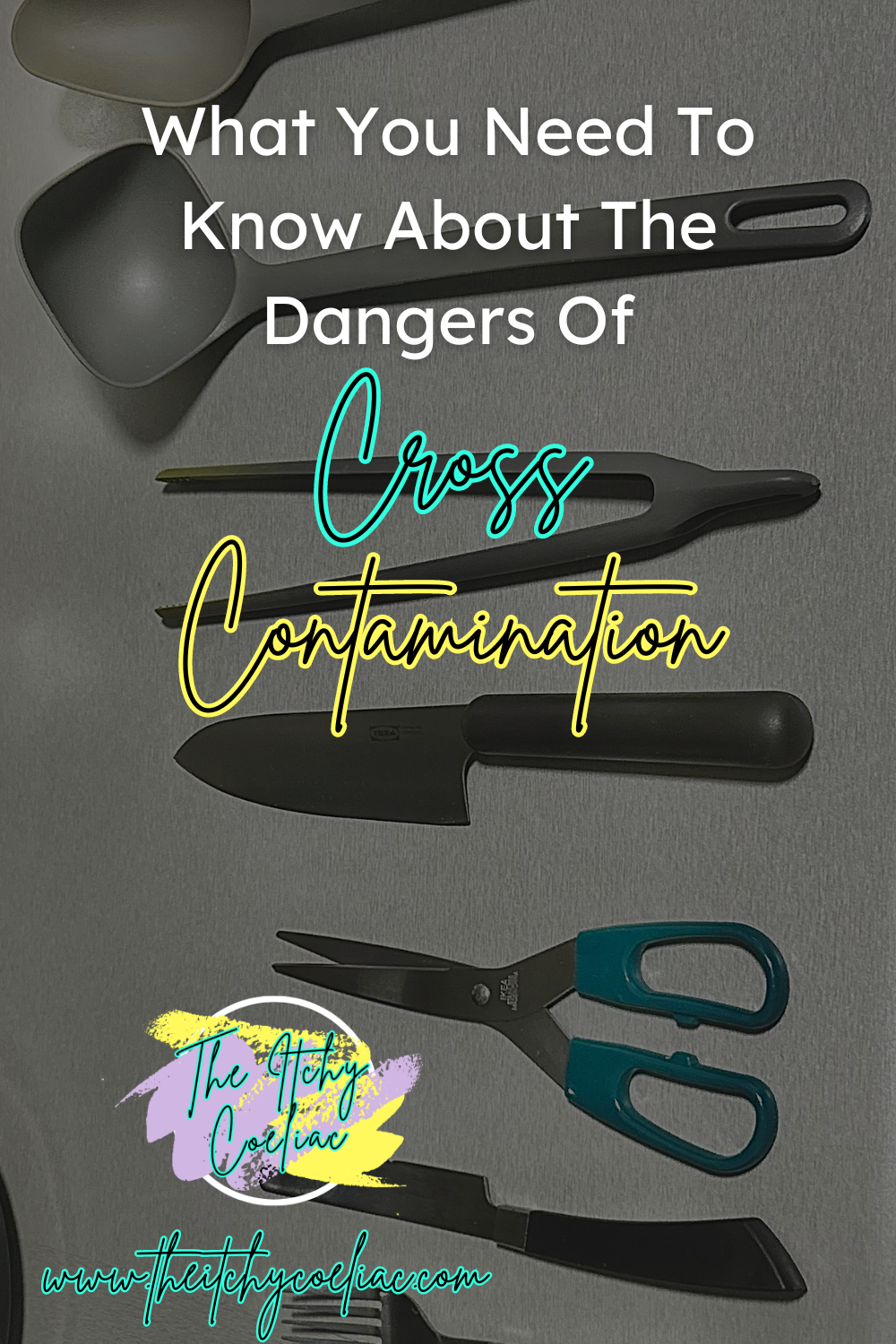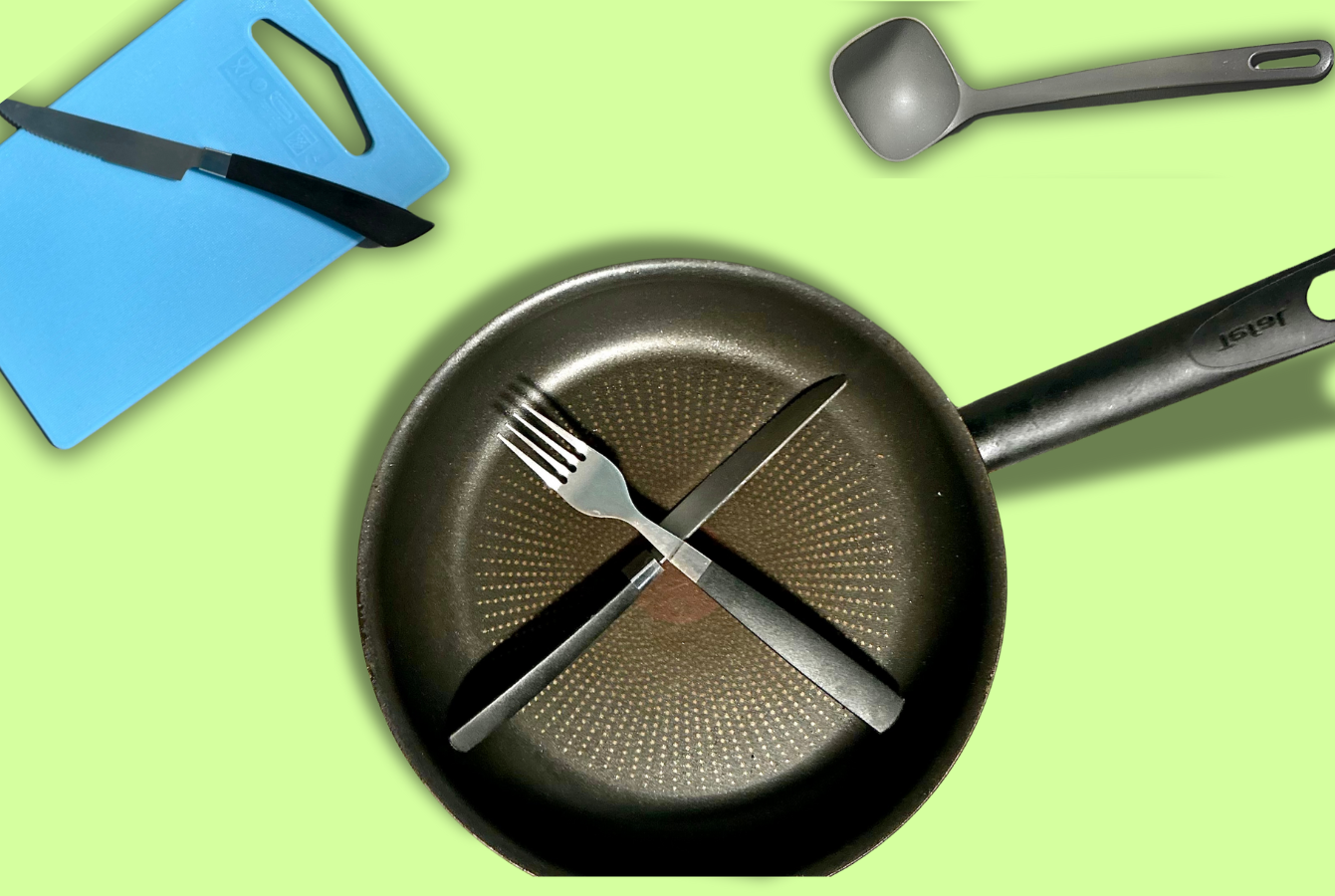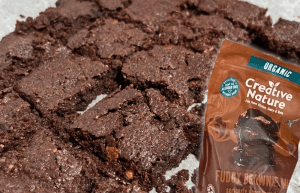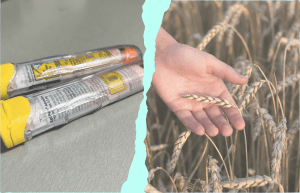When I was first diagnosed with Coeliac Disease, cross contamination was something I had never even heard of. It turns out it is actually a super important part of making sure you’re sticking to a gluten free diet!
Why not pin it for later?
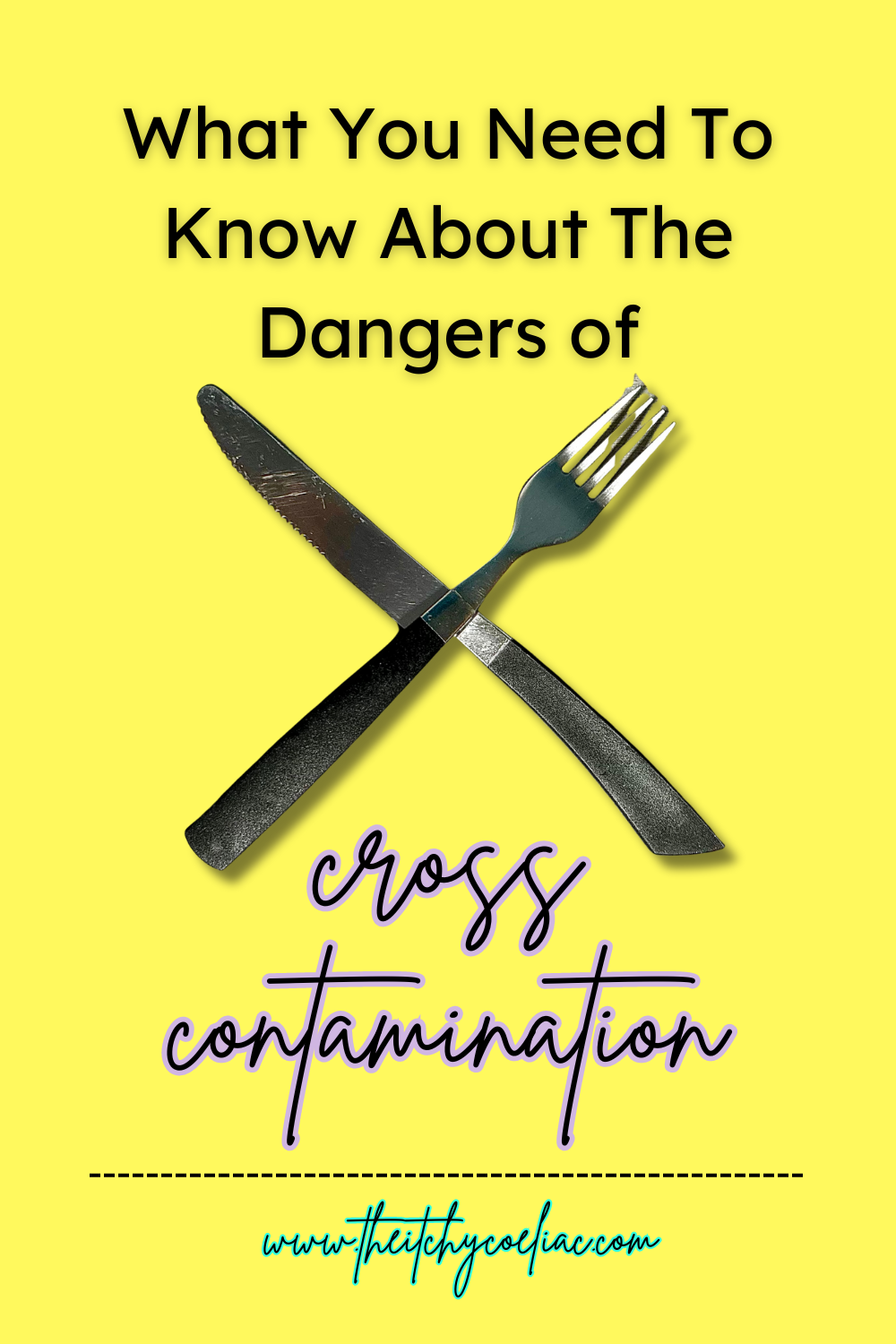
Those of us with Coeliac Disease are not only given the task of making sure there is no gluten in the food we’re eating. We also have to be vigilant when it comes to making sure that food has not been exposed to anything that might have gluten in it.
Plus, it’s not just your food! There are a lot of places where there can be a risk of cross contamination. Keep reading to find out exactly what you need to know about cross contamination, the risks it has and a few tips for navigating this particular aspect of having Coeliac Disease.
So what is Cross Contamination?
By now you should know that those with Coeliac Disease must remove all gluten from their diet to prevent internal damage.
If you didn’t know this make sure to get up to speed by reading my guide, Coeliac Disease: Learning the Gluten Free Life!
Cross contamination occurs when gluten-free food is exposed, either to gluten free foods or surfaces. Things as small as crumbs can be dangerous as they can contain enough gluten to cause a reaction, just the same as if a Coeliac had eaten a whole bowl of pasta.
No matter if it is simply a trace amount of gluten, it will still cause damage – even if there are no obvious symptoms.
Where can Cross Contamination happen?
Some places to watch out for cross contamination are obvious. Places such as the kitchen or any shared surfaces where food is prepared can be at risk. But there are some less obvious places that you need to watch out for!
Kitchen Utensils
A big culprit for cross contamination are kitchen utensils. This could be anything from your ladles to your toasters.
If you live in a household where the kitchen utensils and appliances are shared between Coeliac and non-Coeliac, you have to be careful when using them.
That knife that’s been left on the side after your partner used it to cut their pizza? Should not then be used to cut your gluten free pizza as there could still be gluten left on the knife. This is where the food would become cross contaminated.
Toasters are another area of the kitchen where gluten can be hiding without you knowing! Again, if you’re in a shared household this can be especially difficult to manage.
When someone in your family uses the toaster with regular, gluten containing bread crumbs can be left in the toaster. So when you go to stick your gluten free bread in the toaster, it can very easily pick up those crumbs! And just like that – boom! Your toast has been cross contaminated.
Examples: Toasters, colanders, knives, forks, shared containers…
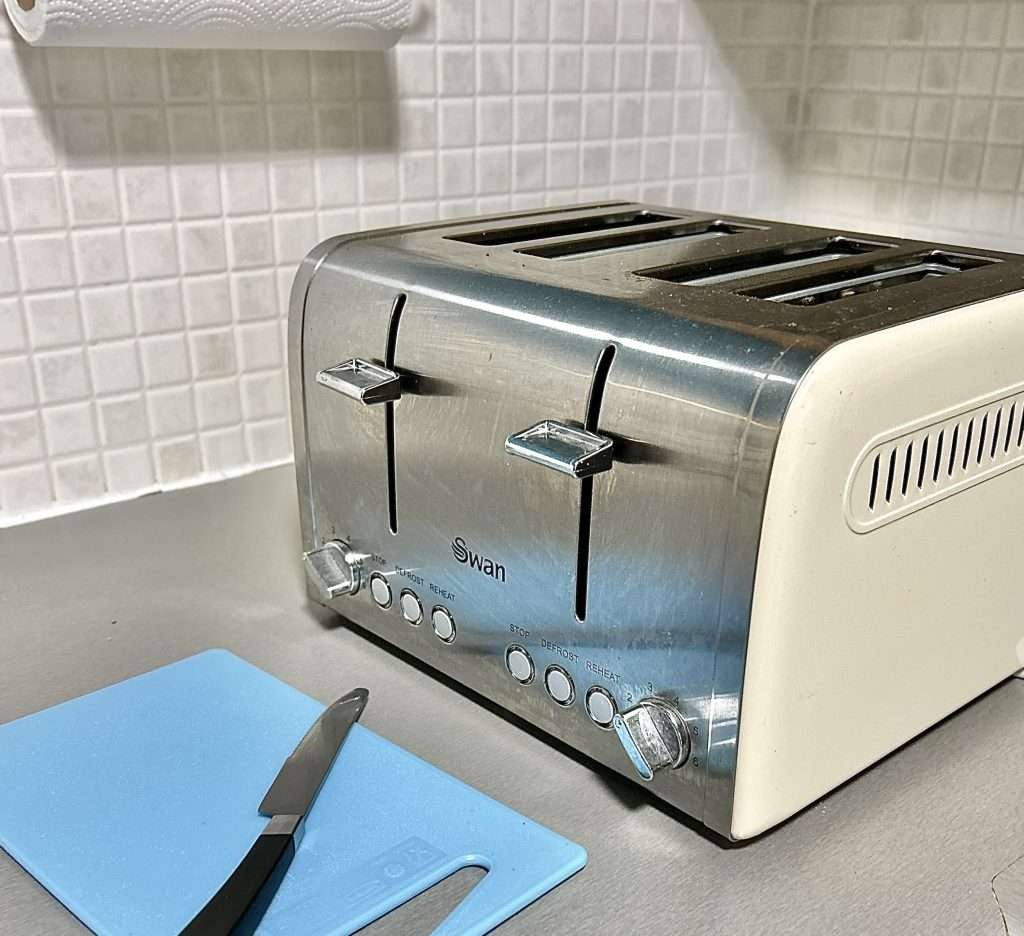
Shared Cooking Surfaces
Whether it’s the work tops in the kitchen or the pots and pans you use, they all can be guilty of hiding traces of gluten.
If surfaces aren’t wiped down properly, crumbs and gluten containing products can be left behind. This can be dangerous and lead to cross contamination.
This is also true for pots and pans. Anything that might not have been washed properly can be at risk of causing cross contamination!
Examples: kitchen worktops, pots, pans, woks, cutting boards…
Shared Ingredients
Sharing products can be tricky. You might think they should be safe, especially if you’ve taken the time to make sure they’re gluten free. But even your gluten free products can be cross contaminated.
For example, you might share butter as a family. Butter? Generally gluten free. But wait! When it’s used by everybody, gluten can find its way in there. There’s a lot of knives being used for different things all going in and out of that butter. Gluten free bread, regular bread, crumpets, gluten free ciabatta rolls, etc.
If in doubt, don’t double dip your shared ingredients and condiments!
Examples: butter, peanut butter, jams, mustard, mayonnaise…
Restaurants and Takeout
One of the reasons eating out with Coeliac Disease is so difficult is because there is a very high risk of cross contamination. In busy kitchens where there are multiple people working all making different dishes, it can be much harder to ensure everything is kept 100% safe.
There’s a lot to think about and not all restaurants are too savvy about the dangers of cross contamination and the negative effects it can have on someone with Coeliac Disease.
Examples: French fries cooked in shared fryers, pizza where both gluten and non-gluten options are available, bakeries storing gluten items on shelves above gluten-free items…
Packaged food
All Coeliacs know that reading food labels is just a habit you have to learn whether you like it or not! It’s especially important when trying to discern if there are any chances of cross contamination with the foods you’re choosing.
A lot of gluten free food can be found outside of the ‘free from’ aisles but you want to be extra vigilant when checking their labels.
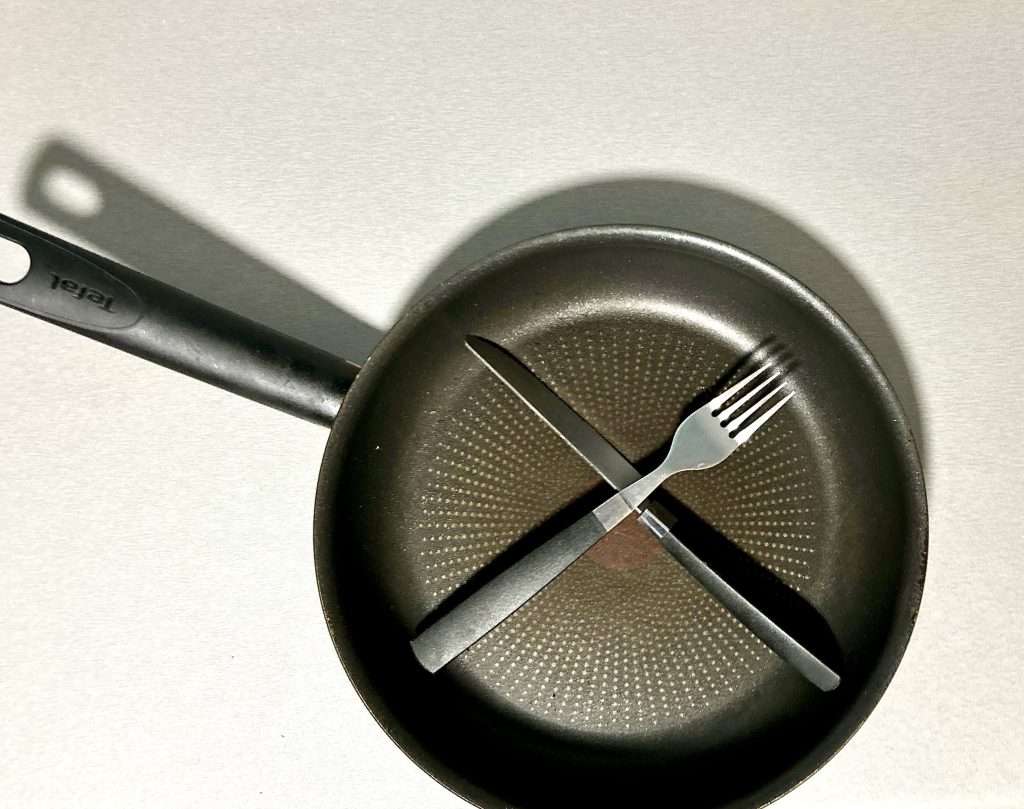
These are foods which can be more likely to have warnings of cross contamination. If you see a label that says it ‘may contain’ an allergen, it’s basically saying it cannot guarantee that there hasn’t been some cross contamination somewhere along the line.
Examples: ‘This product may contain GLUTEN/WHEAT/BARLEY/ETC’
But it’s just a tiny bit, it can’t hurt right?
Wrong! I’m sorry to say but unfortunately, yes even a very tiny amount of gluten can be damaging. This is why it’s so important to be aware and proactive when it comes to cross contamination when you have Coeliac Disease.
While it may only be the tiniest crumb, if it contains gluten then your body is going to have the same reaction you’d get from ingesting a larger amount.
For those of us with Coeliac Disease, even a small amount of gluten can cause some issues. Some might be immediate like bloating, sickness, diarrhoea or cramping. In some cases, we may not actually show any symptoms that there’s anything wrong. If the gluten consumed is a trace amount, you might not get external symptoms. But that doesn’t mean it’s not hurting you!
You’re still getting the same reaction you normally would when eating gluten as someone with Coeliac. Your body creates an autoimmune response and attacks the villi that live in the lining of your intestines.
So even with just a little bit of gluten, you’re at risk of digestive issues, difficulties absorbing the necessary nutrients and vitamins and long term health complications.
Cross contamination was something I didn’t really think much of when I was first diagnosed with Coeliac Disease. After all, I’m a silent Coeliac so I don’t show symptoms of being glutened normally so I wouldn’t notice if I’d been exposed to a small amount of gluten.
Thankfully after it kept coming up and I did a bit more research into it, I was able to fully realise just how risky it can be.
Find out more about what it means to be someone struggling with silent Coeliac in my post, Suffering In Silent Coeliac!
How can you avoid Cross Contamination?
Making sure that your food doesn’t have any cross contamination can be a bit of a chore sometimes. You have to be aware of the surroundings your food is being prepared in. Do not be afraid to speak up for yourself if you need to. However, it doesn’t have to be too difficult. Here’s a few practical tips for avoiding cross contamination when you have Coeliac Disease.
Have gluten free dedicated cooking tools and utensils
The easiest way to make sure that the spatula hasn’t just been used to put someone else’s burger onto their fluffy white roll (possibly contaminating it!) is to have your own!
By having your own dedicated set of kitchen tools you can eliminate any worry that someone has used it before you in a way that could be dangerous. You can make it clear which are yours by adding a label or colour coding them. Then there’ll be no mix ups!
They should also be stored in a separate area to the ‘everyday’ kitchen equipment. Just to make sure nobody uses them by accident. Plus, you should ensure they’re kept somewhere it would be unlikely for them to come into contact with any gluten containing ingredients accidentally.

Clean your surfaces within an inch of their lives
Before going to cook your meal, you must wipe down all kitchen surfaces that might have been in contact with gluten. Kitchen worktops, stoves, chopping boards, and anything else you might use to lay food on while preparing it.
If you’re living in a shared household, you can’t always be sure the person who’s been in there before you has cleaned after themselves properly. This is especially true if living with small kids, who might not fully understand the importance of it. I know my youngest sister wouldn’t think twice before grabbing a snack and leaving the kitchen counter covered in crumbs!
Those that are lucky enough to have a big kitchen might want to think about assigning a gluten-free only area. This can help limit those cross contaminants when cooking. Even if you do try this, you should still make sure to wipe down all your surfaces beforehand. Just in case!
Stand up for yourself and your health if you need to
Arguably one of the hardest places to limit the potential of cross contamination is restaurants and take out places. It’s not like you can just run in the kitchen, wipe down the surfaces and hand them your brought from home utensils!
But this doesn’t mean you should shy away from eating out. It just means you have to be a bit more on the ball.
Generally if you’re looking to eat out, make sure to do your research on wherever you’re going. Check their menu for gluten free options. Check if there are any warnings about possible cross contamination. Then make an informed decision on if that place is right for you.
It’s also best to double check everything when you arrive with the staff. Alert them immediately that you have Coeliac Disease and double check that the food you’d like to order is definitely gluten free.
You can also ask questions like:
- Are [so and so] cooked in their own dedicated fryer?
- Do you use fresh ingredients so they’re not taken from the same tub as a gluten meal?
- Is there a dedicated work space for gluten free meals?
Don’t be afraid to ask the questions so you can ensure your safety. If you’re socially introverted like me, it can feel like you’re being a nuisance but trust me, you aren’t. The last thing you want is to not ask and pay the price for it later on!
I also have a nut allergy so I have to be careful in that respect as well. Having that allergy has helped me to think more clearly about my Coeliac Disease (even though it is not an allergy!). I just think what if someone presented me with a dish that had peanuts on the side? Then ‘fixed’ it by simply brushing them off the plate; would I still eat it? No, of course not. So why is that any different for gluten?
Ask the questions, be a nuisance. At the end of the day it’s your health that is important!
Be aware and be vigilant against Cross Contamination
When you have Coeliac Disease, discovering that you have to be on high alert for even the smallest amount of gluten is frustrating. Especially when you’re new to it!
There’s a lot to think about and a lot to remember. It can make things like living in a shared household or going out to eat a meal much more complicated than they are for someone without Coeliac. But it’s important that you try to move past the frustration and understand just how important it is.
Just try to think of it like this: you’re putting all this hard work into making sure you’re eating a completely gluten free diet. Why let all that go to waste when you’re unintentionally glutening yourself through cross contamination?
Keep cooking utensils, tools and ingredients separate from those being used in gluten containing dishes. Get into the habit of wiping down all surfaces both before and after preparing a meal. Don’t be afraid to ask important questions about how your food is being made. Remember that even trace amounts of gluten can be damaging to your body – even if you don’t notice it at the time.
So hopefully that has given you a bit of insight into the dangers of cross contamination with Coeliac Disease. Did you know about cross contamination? Let me know in the comments!
If you have Coeliac Disease, make sure to share this post! It’s always helpful to raise awareness to others about cross contamination!
